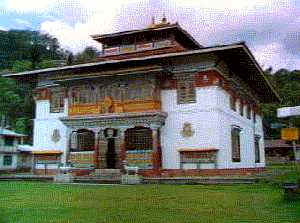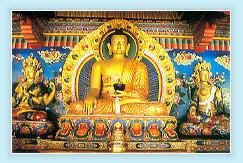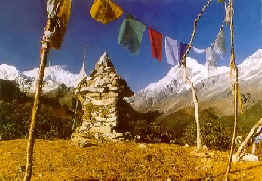




IMAGES AND SYMBOLS
Monastries and many buildings in Sikkim are richly decorated with symbols and icons. These symbols are painted or embossed on the walls or on Tankas. These paintings may depict the life of Buddha or some Tibetan saint, the Wheel of of Life or a diety surrounded by lesser deities. Wheel of Life The Wheel of life is one of the purest Buddhist emblems. This emblem can be seen in the entrance of almost all the monastries. This emblem is also widely depicted on thankas or religious scrools. The circular form of this wheel symbolizes the ceaseless worldly existence. This wheel is held in the clutches of a monster with its claws and teeth and signifies the pastionate clinging of the people to existr in this world. The hub of the wheel contains a cock, a snake and a pig. The cock signofies lust or desire, The snake signifies anger anf the pig symbolises ignorances and stupidity. These are shown in the center of the wheel as it is said that they are the root cause of the trouble on earth. In the intermediate circle of the wheel of life, the five worlds are drawn as advised by lord Buddha. The ring between the intermediate world and the inner most circle of ignorance, lust and envy is drawn in half white and half black. White area symbolises good deeds and Black symbolises bad or evil deeds. People going upwards in White portion represent people who have performed good deeds in theirt lifetime and are now going to take rebirth in the world of gods. People going in the Black portion indicate hell or the world of animals. In the intermediate circle there are five parts that of which the two upper parts symbolise heavenly and human worlds. The remaining three worlds in the lower path symbolise sinful deeds leading to a world of animals, ghosts and hell. Outermost circle shows twelve phaces of life.Eight lucky signs and their significance:

Sikkim's near about 200 monasteries or Gompas belonging to the Nyingma and Kagyu order have not only been influencing the cultural heritage and lifestyle of the people, but also demonstrates the ancient rituals in practice.
Devoted Lamas robed in red, chant ancient mantras to the rhythm of drums and trumpets while soft lights flicker from decorative lamps placed before statues of the great Guru Padmasambhava. Feel the peace and quiet of being one with nature and close to the almighty as sacred words mingle with the whirring prayer wheels.
The Gompas are adorned with life-like frescoes of hoary Buddhist legends, rare silk and brocade Thangkas. Also preserved here, are ancient Tibetan manuscripts, exquisitely carved wood work and icons of silver and gold.
Pemayangtse Monastery is situated in West Sikkim at Gyalshing (140 kms. from Gangtok) and commands an impressive view of Mount khanchendzonga. This monastery belongs to the Nyingma order and all other Nyingma monasteries in Sikkim are subordinate to it.
24 Kms. from Gangtok, a drive through beautiful countryside takes one to Rumtek Dharma Chakra centre built in 1960'S by his holiness the late 16th GYALWA KARMAPA when he took refuge in Sikkim after the Chinese attack. It houses some of the worlds most unique art objects, ancient manuscripts and icons.
This monastery is situated in Gangtok on a hill top. It was built during the reign of Thutob Namgyal .
This monastery was built in 1721 during the time of Jigme Pawo. In 1947 it was completely gutted by a devastating fire. However it was rebuilt in 1948. It is present in North Sikkim.
This monastery is in North Sikkim 28 kms. from Gangtok. The original monastery is rebuilt and is today one of the most beautiful monasteries in Sikkim.
This is another important monastery belonging to the Nyingmapa order and is about 40 Kms. from Gyalshing by road via Legship (West Sikkim). It lies nestled on the top of a hill that looms up between the Rathong river and the Rangit river and is surrounded by a profusion of Prayer flags that flutter in the air.
SANGA CHELLING MONASTERY
Sanga chelling means ' the island of esoteric teaching'. This monastery was built in 1697 and is situated about 7 kms. from Pemayangste. It is said to be the oldest monastery in Sikkim.
DUBDI MONASTERY
Dubdi means 'the retreat' and this monastery was built in 1700. It is located near Yuksum on a hill top. One has to travel by foot to reach it.
KHECHOPARI MONASTEREY
This monastery is located just above the famous near Yukusm.
MELLI MONASTERY
Melli basically means 'a lepcha village'. This monastery is also located near Yuksum.
SINON MONASTERY
Sinon means 'the suppressor of intense fear'. The monastery was built in 1716 and is located about 10 kms. from Tashiding on a hill top.
DALLING MONASTERY
Dalling means 'the thunderbolt'. This monastery was built in 1840 and is situated near kwezing in .
YANGYANG MONASTERY
Yangyang means 'the ridge of fortune'. This monastery was built in 1840 and is situated at a place called Yangyang 10 kms. downhill from Rabongla.
NAMCHI MONASTERY
This monastery is located in Namchi, the district headquarters of south district and was constructed during the reign of Chogyal Gurmed Namgyal.
KWEZING MONASTERY
This monastery is located near Kwezing in South Sikkim. It was built during the reign of Chogyal Thutob Namgyal.
SIMIK MONASTERY
This monastery is situated in near Singtam town. It was built during the reign of Chogyal Tsudphud Namgyal.
HEE GYATHANG MONASTERY
This monastery is located in and follows the Nyingma sect of Buddhism.
LINGTEM MONASTERY
This monastery is located in the Zongu area of North Sikkim.
CHAWANG ANI MONASTERY
This monastery is located near Phensang which is on the highway between Gangtok amd Mangan. It was built during the reign of Chogyal Tshudphud Namgyal .
RHENOCK MONASTERY
This monastery is located in bout 63 kms. from Gangtok.
KHATOK MONASTERY
This monastery is located in East Sikkim near Pakyong. The present structure of the monastery was built during the reign of Chogyal Thutob Namgyal.
BERMOIK MONASTERY
This monastery was constructed in 1952 and follows the Nyingma sect of Buddhism. It is situated in South Sikkim above Singtam.
LACHEN MONASTERY
This monastery in North Sikkim was built in 1806 and follows the Nyingma sec of Buddhism.
LACHUNG MONASTERY
This monastery in North Sikkim was built in Sikkim 1880 and also follows the Nyingma sect of Buddhism.
SANG MONASTERY
This monastery is situated near Rumtek and was built in 1912.
RALONG MONASTERY
This monastery is situated near Rabongla in South Sikkim.

COPYRIGHT : SUVANKAR SANYAL, ALL RIGHTS RESERVED